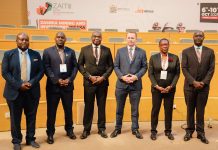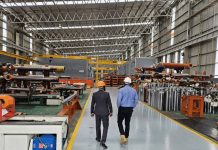It was just over a decade ago that Zambia was producing barely 400 000 tonnes of copper; and more than 80% of it came from the Copperbelt.
By 2016, the situation had changed completely. Zambia’s copper production had shot up to nearly 800 000 tonnes, and North-Western province was producing some two-thirds (66%) of it.
It was an amazing transformation of a once rural, remote province with very little economic activity into a thriving commercial hub that generates wealth, employment and tax revenue that is the envy of the rest of Zambia.
This metamorphosis was the inspiration for the Chamber of Mines latest report, The 10-year miracle – the story of mining in North-Western Province, which was released on 27 Feb 2018
“Within barely a decade, North-Western Province has seen the creation of not just one new mine, but three – Barrick Lumwana, as well as Kansanshi and Sentinel mines, both majority-owned by First Quantum Minerals,” the report says. “When all the associated infrastructure is included, it presents an investment of some $7 billion. That is the single-largest round of direct fixed investment of recent years that a Zambian province has seen in so short a space of time.”
A fact not always appreciated today is that these were challenging, risky investments. The copper grade in North-Western province was as low as 0.5%, compared to 3% or more on the Copperbelt; the mine sites were in remote locations with none of the infrastructure – roads, airports, power, water, housing, skilled labour – necessary to run a modern mining operation.
Chris Mukala, Sustainability Manager at Barrick Lumwana, recalls that during the construction of Lumwana mine, management and workers lived in tents for two years; snakes were a daily danger; the main office was a disused shipping container; and board meetings were held under a tree.
The question arises: why did these companies even bother? The answer: there was an enabling environment at the time that made the risk worth taking. Zambia was able to offer investors a stable, globally competitive Mining Act; favourable tax concessions; very low mineral royalties (less than 1%); abundant, competitively priced power; and a peaceful, politically stable country.
The resulting mining boom hit the area – particularly Solwezi – with the force of an express train. Suddenly, there was economic opportunity, jobs and spending power. Businesses sprung up like mushrooms to meet the new consumer demand. The population swelled, drawn by the lure of employment and opportunity. Hotels were booked out for months at a time. FQM’s Kansanshi Mine in Solwezi could no longer find homes for all its employees, so they built an entire new neighbourhood – Kabitaka – at a cost of $100 million.
The rampant growth wasn’t without its problems. “The surging population put pressure on public services such as water road infrastructure, and health and education facilities,” the report says. In response to the pressure created by the new mining activity, Kansanshi and Lumwana embarked on a major multimillion-dollar infrastructural drive, building houses, clinics, roads, classrooms – and even upgrading Solwezi airport.
It was partly to avoid this kind of chaotic development that FQM decided to start with a clean slate when building the town of Kalumbila to support their new Sentinel Mine, which was scheduled to start production in 2015.
The town was designed by an international urban-design consultancy, required an investment of $200 million, and boasts an airport; proper infrastructure; water, sewerage and street lighting; shops, businesses and leisure facilities; schools and medical facilities. Kalumbila has attracted private investment, the most recent example of which is a $40 million Chilean manufacturing plant scheduled to open in 2018, and which will produce mill-balls for Zambian and international mines.
“The town’s long-term ambition is to become economically self-sustaining, so that it doesn’t depend on Sentinel Mine for its existence,” the report says.
The existence of three modern, world-class mines has had a profound economic effect on the livelihoods of ordinary people, creating employment and increasing disposable income.

Massive supplier spending of between $1 billion and $2 billion a year sustains numerous businesses and their employees, not just in the province, but in the Copperbelt and Lusaka too; more than $100 million of supplier spend ends up in Solwezi alone.
The wages of some 20 000 employees and contractors releases more than K100 million every month into the economy, a significant portion of which ends up in Solwezi. “The regular injection of wages and salaries into the local economy explains the plethora of shops, stores and businesses of all sorts that have sprung up around Solwezi in the past decade,” the report says.
And thanks to what is known as the multiplier effect, the impact of mine and employee spending goes far beyond the mine gates, and sustains employment in businesses that are not even directly connected with mining.
“For many, the contribution of the mining industry to Zambia’s economic health and social well-being is often seen through the narrow lens of tax revenue and royalties,” says Chamber of Mines chairman, Nathan Chishimba, quoted in the report. “[But] they are just the tip of the iceberg; the real sustainable contribution the mines make every day is on the ground, in towns and communities, by being the catalyst for economic growth, employment and rising disposable income.”
The report says that North-Western Province can continue to grow and expand its mining and commercial activities, as long as there is an attractive enabling environment, and various challenges facing Zambian local businesses (e.g. high costs of credit, lack of skills and high tax rates) are addressed.
“Taken in the right spirit, [this] can be a useful aid for Zambia’s policymakers in trying to understand the link between investment and economic development, and how to deal with both its successes and challenges,” the report concludes.
Click here to download the full report
See also: Fortune favours the brave
























